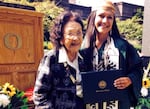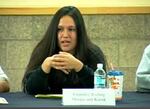
In this 2014 photo, Emmilee Risling (right) poses at her University of Oregon graduation ceremony with her great-aunt and adoptive grandmother, Viola Risling-Ryerson.
Used With Permission From Gary Risling
The months-old disappearance of a Native American woman from California’s Yurok Reservation has raised questions over how missing and murdered Indigenous people cases are handled.
Emmilee Risling, 33, was last seen crossing a bridge in October. An accomplished Hoopa Valley tribal dancer, 2014 University of Oregon graduate, and mother, she’s one of five cases in 18 months of Native women gone missing or found murdered between California’s Bay Area and the Oregon border.

In a still from a U of O video from March 5, 2010 Emmilee Risling, of the Native American Student Union, talks about Indigenous issues with fellow student panelists.
Oregon Media / Https://Media.Uoregon.Edu/Channel/Archives/991
“Everyone wants her home,” Emmilee’s sister, Mary, told KLCC. “Everyone who my sister touched, misses her. And wants to see her back with her children.”
Risling said she’s been frustrated with the attention paid to other cases, like the disappearance-homicide case of Gabby Petito last year. Critics have noted that Petito - a young and attractive white Instagrammer – garnered national headlines for weeks, while MMIW cases have rarely made a blip in social media and traditional media save for tribal newspapers. Risling said both law enforcement and the public need to focus more on cases like this one.
“It’s just a helpless feeling. Indigenous women. You know there’s statistics out there, but … given the fact that the cases don’t get much attention, there would be a lot more information if they did.”

A flyer shares last known details of Emilee Risling before she disappeared Oct. 18, 2021.
Handout
Risling added that Emmilee struggled with mental health issues in the months ahead of her disappearance, and that can add another layer of stigma.
“The amount of times my sister has been picked up over the years by the (Humbold County) sheriff, it’s like, ‘Let’s get her in trouble, but let’s not help her.’ When police officers have a certain number of run-ins with a person, and they go missing … they have this stigma over who this person was, or who they thought she was.”
The Yurok Tribe has declared a state of emergency. They want California to form a comprehensive database of cases of missing and murdered Indigenous people. MMIW advocates have long called attention to conflicting sources of data in trying to track cases, with varying definitions or thresholds.
Meanwhile, the Risling family appreciates opportunities to spread awareness of Emmilee’s disappearance, and of missing and murdered Indigenous women in general.
“Whatever it takes to help get the word out,” Gary Risling told KLCC, after granting permission to use his missing daughter’s U of O graduation photo. “We want the word to spread far and wide about the challenges in helping investigate and solve these cases.”
A group called Sovereign Bodies Institute has set about doing its specialized research on missing and murdered Indigenous women, girls, and Two Spirit (MMIWG2) cases, and noted that California — with 150 — ranked fifth in the nation, with more than a third of cases in the northern half of the state.
Another challenge facing relatives, women’s advocates, and tribes, is the question over jurisdiction. And red tape.
“We’d reached out to the BIA for support and other federal organizations, and until the sheriff’s department classifies it as a cold case, federal organizations can’t help,” said Mary Risling.
“We all feel helpless.”
Anyone with information on Emmilee Risling’s disappearance or whereabouts can call Hoopa Tribal Police Dispatch (530) 625-4202.
Copyright @2022, KLCC